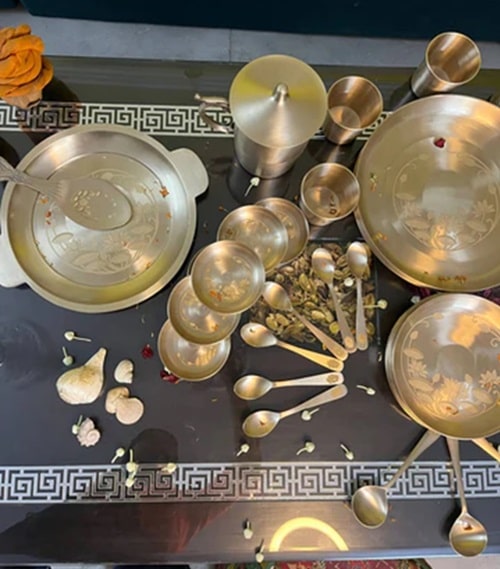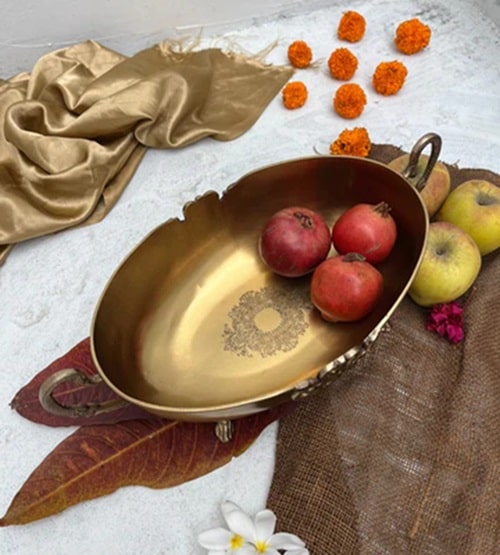At BrassGlobe, we understand that your cookware is an investment. The beauty and potential health benefits of brass, copper, and kansa cookware can be enjoyed for generations with proper care and cleaning. This comprehensive guide delves into the best practices for maintaining the luster and functionality of these timeless metals.
Understanding the Metals: Tailored Cleaning Approaches

While brass, copper, and kansa share some similarities, each metal has unique properties that require slightly different cleaning methods. Here’s a breakdown of the key points to consider:
- Brass: A resilient alloy of copper and zinc, brass is generally easier to maintain compared to copper. It’s less prone to tarnishing and reacts minimally with acidic foods.
- Copper: Renowned for its exceptional heat conductivity, copper is susceptible to tarnishing and reacts with acidic ingredients. Regular cleaning is crucial to maintain its gleam and prevent discoloration.
- Kansa: Primarily composed of tin and copper, kansa develops a soft patina over time. Acidity can affect the taste of food served on kansa and cause discoloration.
General Cleaning Principles for All Three Metals
- Frequency: Clean your brass, copper, and kansa cookware after each use to prevent food residue buildup and maintain hygiene.
- Temperature: Use warm water for cleaning. Avoid boiling water, as it can damage the cookware.
- Detergent: A mild dish soap diluted in warm water is sufficient for most cleaning tasks. For stubborn stains, a white vinegar solution (1 part vinegar to 3 parts water) can be used.
Brass Cleaning Techniques:
- Routine Cleaning: Wash your brass cookware with warm, soapy water and a soft sponge. Rinse thoroughly and dry completely with a clean, soft cloth.
- Tarnish Removal: For mild tarnish, a paste made with lemon juice and salt can be applied to the brass surface. Rub gently with a soft cloth, rinse thoroughly, and dry completely. Alternatively, you can use commercially available brass cleaners following the manufacturer’s instructions.
- Stubborn Stains: For tough stains, create a paste with baking soda and water. Apply it to the stained area, leave it on for a few minutes, and scrub gently with a soft sponge. Rinse thoroughly and dry completely.
Copper Cleaning Techniques:
- Routine Cleaning: Similar to brass, wash your copper cookware with warm, soapy water and a soft sponge. Rinse thoroughly and dry completely with a clean, soft cloth.
- Tarnish Removal: Copper tarnishes more readily than brass. For mild tarnish, a paste made with lemon juice and salt can be effective. Alternatively, you can use a white vinegar solution (1 part vinegar to 3 parts water) applied with a soft cloth. Rinse thoroughly and dry completely. Buff the copper with a soft cloth to restore its shine.
- Stubborn Tarnish: For stubborn tarnish, create a paste with ketchup and apply it to the surface. Let it sit for 10-15 minutes, then rub gently with a soft cloth. Rinse thoroughly and dry completely. Another option is to use a commercially available copper polish following the manufacturer’s instructions. Important Note: Avoid using abrasive cleaners or scouring pads on copper, as they can scratch the surface.

Kansa Cleaning Techniques:
- Routine Cleaning: Wash your kansa serveware with warm, soapy water and a soft sponge. Avoid harsh abrasives or scouring pads. Rinse thoroughly and dry completely with a clean, soft cloth.
- Maintaining the Patina: Kansa develops a soft patina over time, which is considered desirable. Avoid using harsh cleaning methods that may remove this patina.
- Discoloration from Acidity: If acidic food has caused discoloration on your kansa serveware, you can try a gentle lemon and salt paste or a white Svinegar solution (1 part vinegar to 3 parts water). Apply it with a soft cloth, rinse thoroughly, and dry completely.
Additional Tips for Maintaining Your Brass, Copper, and Kansa Cookware:
- Storage: Store your brass, copper, and kansa cookware in a cool, dry place away from direct sunlight. Moisture and humidity can accelerate tarnishing, so ensure proper ventilation in your storage area.
- Don’t Stack: Avoid stacking your brass, copper, and kansa cookware directly on top of each other, as this can cause scratches and dents. Use pot holders or dividers to create space between each piece.
- Natural Cleaning Alternatives: For those seeking natural cleaning solutions, here are some alternatives:
o Baking Soda: A versatile cleaning agent, baking soda can be used to remove light stains and deodorize your cookware. Make a paste with baking soda and water, apply it to the surface, leave it on for a few minutes, and scrub gently with a soft sponge. Rinse thoroughly and dry completely.
o Ketchup: The acidity in ketchup can be surprisingly effective in removing stubborn tarnish from copper. Apply a thin layer of ketchup to the tarnished area, let it sit for 10-15 minutes, scrub gently with a soft cloth, rinse thoroughly, and dry completely. Note: This method is not recommended for brass or kansa.
o Lemon and Salt: This classic combination can be used to remove mild tarnish from brass, copper, and kansa. Create a paste with lemon juice and salt, apply it to the tarnished area, rub gently with a soft cloth, rinse thoroughly, and dry completely.
- Know When to Seek Professional Help: For heavily tarnished or damaged cookware, consider seeking professional cleaning services. They can use specialized techniques and polishes to restore the shine of your brass, copper, or kansa without damaging the metal.
Embrace the Journey: The Beauty of Patina
While maintaining the gleam of brass and copper requires regular cleaning, it’s important to acknowledge the beauty of the patina. Patina is the natural layer that develops on these metals over time, creating a unique and characterful appearance. In the case of kansa, the soft patina is considered desirable and adds to the charm of the cookware.
By following these cleaning practices and embracing the natural aging process, you can ensure your brass, copper, and kansa cookware not only functions beautifully but also becomes a treasured heirloom passed down through generations.
Santosh Kumar, He is a SEO + Blogger have 12 years of experience in writing tutorial, informative and product reviews topics.
Page Contents

